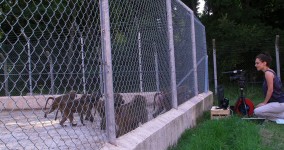
Primate Cinema: Baboons as Friends
Two Channel Installation, Mini-DV and HD, Loop
Single Channel Splitscreen, Mini-DV, 5:45, 2007
Primate Cinema is a series of video experiments that translate primate social dramas for human audiences. The first experiment, Baboons as Friends, is a two channel video installation juxtaposing field footage of baboons with a reenactment by human actors, shot in film noir style. A tale of lust, jealousy, sex, and violence transpires simultaneously in human and nonhuman worlds. Beastly males, instinctively attracted to a femme fatale, fight to win her, but most are doomed to fail. The story of sexual selection is presented across species, the dark genre of film noir re-mapping the savannah to the urban jungle.
As an installation, the project presents the viewer with raw field footage of baboons in Kenya, shot by primatologist, Deborah Forster, on the left. The reenactment, in high definition video, was scripted and directed by the artist with actors in Hollywood, shown on the right. The sound in the gallery space combines the vocalizations of the baboons with the ambience of a bar, without dialogue. The viewer may choose to listen to a narration by the primatologist, describing the behavior of primates, found on headphones. The project is also distributed as a single channel splitscreen.
Conceptual Background
During the era of film noir, baboons, were thought to be an apt model for human evolution. Moving from the protection of the trees to the open savannah, baboons, like our human ancestors, would have to fight off predators, and hunt for food. Males would protect females, and aggressively fight amongst themselves for rank and reproduction. As human culture changed in the 60’s, the field of primatology changed as well. Baboons were found to be organized matrilineally, and other species became more popular as models for human nature.
Film noir, during World War II, projected a dark view of human nature, telling stories of alienation, survival, and desire. The private eye, the fall guy, the jealous husband were lured into mortal danger, trapped by situations not of their own making, and doomed by irresistible drives. Femmes fatales–sirens of unbridled sexuality, the objects of the male protagonists’ plots–would often lead men to their bleak fates. These tales of urbancrime and murder were cast in expressionistic shadows and darkness.
Film noir’s “hard-boiled” visual style contrasts with the “raw” field footage of baboons. Film narrative applies a lens to nature, which cruelly lacks protagonist and plot. Through actors’ eyes and bodies, viewers of Primate Cinema can begin to distinguish the unique personalities of individual baboons–their fears, desires, and social strategies. Clichés provide a shortcut for understanding the soap opera of baboon life, yet they point back to the fact that representation is always situated within historical and cultural context. The conventions of film noir enable a reading across species but at the same time foreground their incommensurability.
In the last several decades, scientists have re-approached the commonality between human and nonhuman primate minds with new lenses and tools. Primate minds are envisaged to be rational and emotional, embodied, and part of a larger social ecology. Genetic analysis shows that chimpanzees share 98.6% of their genes with homo sapiens. Conservation necessitates a political, culturally situated, empathetic, and interventionist approach to science. As opportunities to study the unruly lives of nonhuman primates in the “wild” continue to vanish, our imagination of our closest relatives may be all that we have left.
Process
To make Baboons as Friends, artist and media studies professor Rachel Mayeri collaborated with cognitive scientist Deborah Forster. Forster videotaped and analyzed the sexual dynamics of consort turnovers for many years at anthropologist Shirley C. Strum’s Uaso Ngiro Baboon Project in Laikipia, Kenya. The collaboration has generated conversations about scientific and cinematic representations of primates, and the issue of anthropomorphism. The top photograph shows, left to right, artist Rachel Mayeri, actors Camillia Sanes, Patrick Mulderrig, and Shaun Madden, with Deborah Forster, explaining baboon basics. The photograph below shows the actors in rehearsal.
Exhibitions and Screenings
“Project Series 39: Rachel Mayeri Primate Cinema.” Pomona College Museum of Art, Claremont, CA.
“Interspecies” exhibition, curated by Arts Catalyst, Cornerhouse Gallery, London, England
“Intelligent Design: Interspecies Art.” Co-curated by gallery director Tyler Stallings and Rachel Mayeri. Sweeney Art Gallery. Riverside, CA
“Interspecies” exhibition, curated by Arts Catalyst, Cornerhouse Gallery, Manchester, England
“Front and Center” Headlands Center for the Arts, Sausalito, CA.
Aspect Magazine: The Chronicle of New Media Art. Volume 12: Vital. December 2008. DVD.
Multispecies Salon, Play Space Gallery, California College of the Arts, San Francisco, 2008
“Body-Art-Disease” Symposium screening, UCLA Art | Sci Center
Recontres International Science Cinema Festival, Marseille, France
Darwin Bicentennial, Ohio State University, Hopkins Gallery
“Primate Cinema,” TELIC Arts Exchange, Los Angeles, CA, May-June 2008
“Hotbed: Video Cultivation beside the Getty Gardens,” Curated by Anne Bray in conjunction with California Video, J. Paul Getty Museum, Los Angeles, CA, May 9 and 10, 2008
“Abstraction,” Fellows for Contemporary Art, Los Angeles
Enter 3, Multimedia Festival, Prague
Mill Valley Film Festival
Chicago Underground film Festival
“Distant Relations” Museum of Contemporary Art in Roskilde, Denmark, April 2007.
Awards
Semifinalist honor, International Visualization Competition, sponsored by National Science Foundation and the JournalScience, 2007.
Co-production award. Banff New Media Institute, Banff Arts Centre
Presentations
“Windows into the Soul: Surveillance in an Age of High Technology” at Harvey Mudd College, March 2008.
MutaMorphosis: Challenging Arts and Sciences in Prague in November 2007
Society for the Social Studies of Science in Vancouver, Canada in 2006BIO [X]: New Iterations of Lively Bodies, Science Studies Graduate Student Conference, at University of California, Santa Cruz in February 2007.
Press
Holly Willis. “Coming up: Intelligent Design.” Blur + Sharpen. KCET.org September 4, 2009.
Meredith Tromble for Aspect Magazine: The Chronicle of New Media Art. Volume 12: Vital. December 2008.
Marisa Olson,”Monkeying Around” Rhizome. June 17, 2008,
Tim Feran. “18 Creators Salute Double Darwin Milestone.” The Columbus Dispatch. November 2008
Production Credits
Michelle…Camilia Sanes
Crook…Patrick Mulderrig
Claiborne…Shaun Madden
Herakles…Randy Tobin
Induli…Andrew Maxwell
Director of Photography…Liz Rubin
Sound Design…Ken Kilmak
Produced with support from the Mellon Foundation New Venture Fund, Harvey Mudd College, and the Durfee Foundation.




